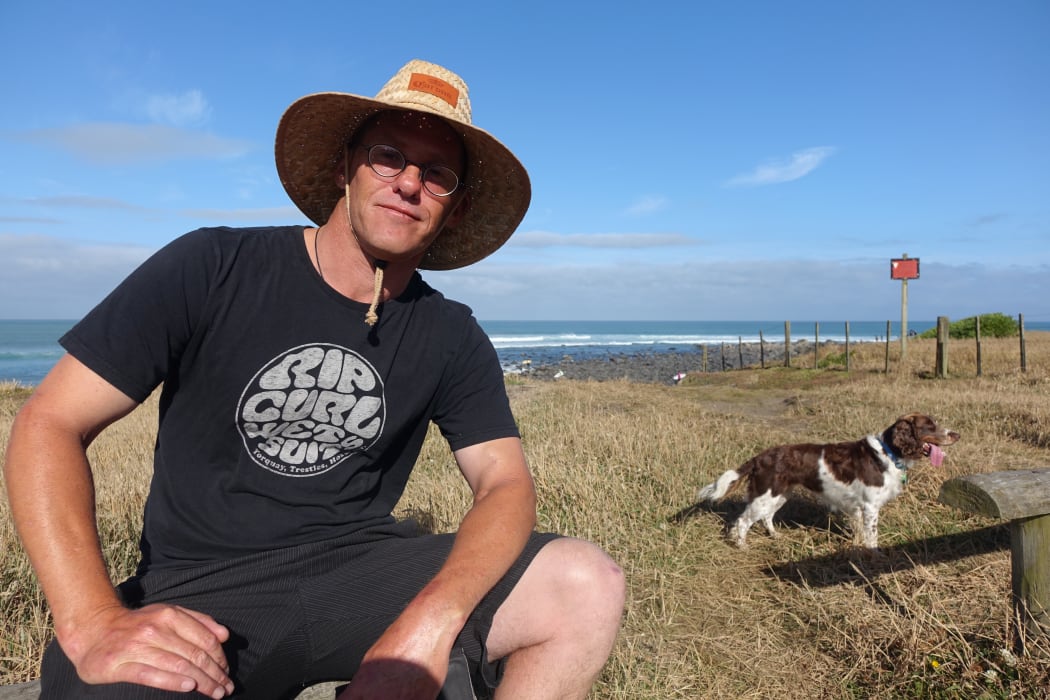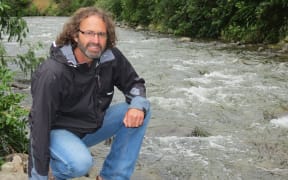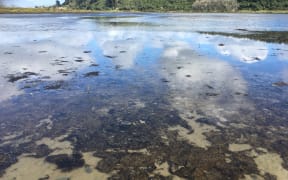Surfers and hapū in coastal Taranaki say they are horrified at an algae bloom that is clogging the area's rivers and streams this summer.

Chris Wilkes Photo: RNZ / Robin Martin
They say the bloom is treacherous to cross, a threat to traditional food gathering practices and evidence of excessive nutrient run-off from surrounding farms.
National Surfing Championships event director Chris Wilkes said the state of the stream and river mouths in the competition area last week were an embarrassment, especially at the Matanehunehu Stream on Paora Road.
"We had huge deposits of slimy algal growth. The whole river basically covered in green slime and the water moving through it.
"We also have massive amounts of green algae growing on the rocks on the reefs at every single river mouth. It's just disgusting."
The Okato local said the nationals attracted 400 surfers from around the country and many were shocked at what they saw.
"We had to erect a bridge where normally you would be able to wade across a stream it was just too slippery so was a total hazard.
"We had to mitigate the risk there by erecting a small scaffolding bridge for people.
"They were saying, 'Well that's a real shame', you know. 'What a beautiful area and look at this.' I mean, basically a lot of people had never seen anything that before and they surf all around New Zealand."

Algae in Taranaki. Photo: Supplied / Chris Wilkes
Mr Wilkes believed the algae bloom was the result of fertiliser and effluent run-off.
Ngā Mahunga hāpu representative Tāne Manu said algae blooms were an ongoing problem but even he was surprised by this summer's inundation.
"The shear amount of algae. I could literally back my truck up - my ute - and I could literally fill my ute up.
"Is that acceptable? From a tikanga Māori perspective, definitely not."
Mr Manu believed the slime was a health risk and he would not swim in local streams or gather kai from them.
"Anyone in the area could potentially come into harm from either visiting the area, wading in a stream, gathering kai from the reefs or the awa [river] itself."
Mr Manu said his hapū was active in awa restoration but there was a lot of work to do.
In a statement, Taranaki Regional Council director of environmental quality Gary Bedford said algae was essential for aquatic ecosystems to grow and thrive.
Mr Bedford said it proliferated during extended periods of slow, low water flows, light and warmth -combined with essential nutrients.
He said the council was doing its bit to tackle nutrient loads.
"The council continues its drive towards planting streambanks along all ringplain rivers and streams, and the diversion of treated dairy effluent discharges from waterways [and] reducing run-off from paddocks."
The council was also helping farmers develop plans to use less fertiliser, Mr Bedford said.
Additionally, if algae was obvious it was not necessarily a concern as he expected the next heavy rain would flush it away.
Mr Wilkes, an unsuccessful regional council candidate in 2016, said that was not good enough.
"The answer lies with the elected officials themselves actually making a stand. It's pretty hard for them to do so when they are literally fertiliser salesmen and dairy farmers themselves.
"The conflict of interest within the Taranaki Regional Council around the table of elected officials is just horrifying."
The regional council was yet to receive an official complaint about the algae bloom.



